Kanchenjunga Base Camp Trek
- 25 breakfast
- 23 Lunch
- 22 Dinner
- Hotel in Kathmandu
- lodges during trek
- Trekking
- Sightseeing
- Scenic Drive
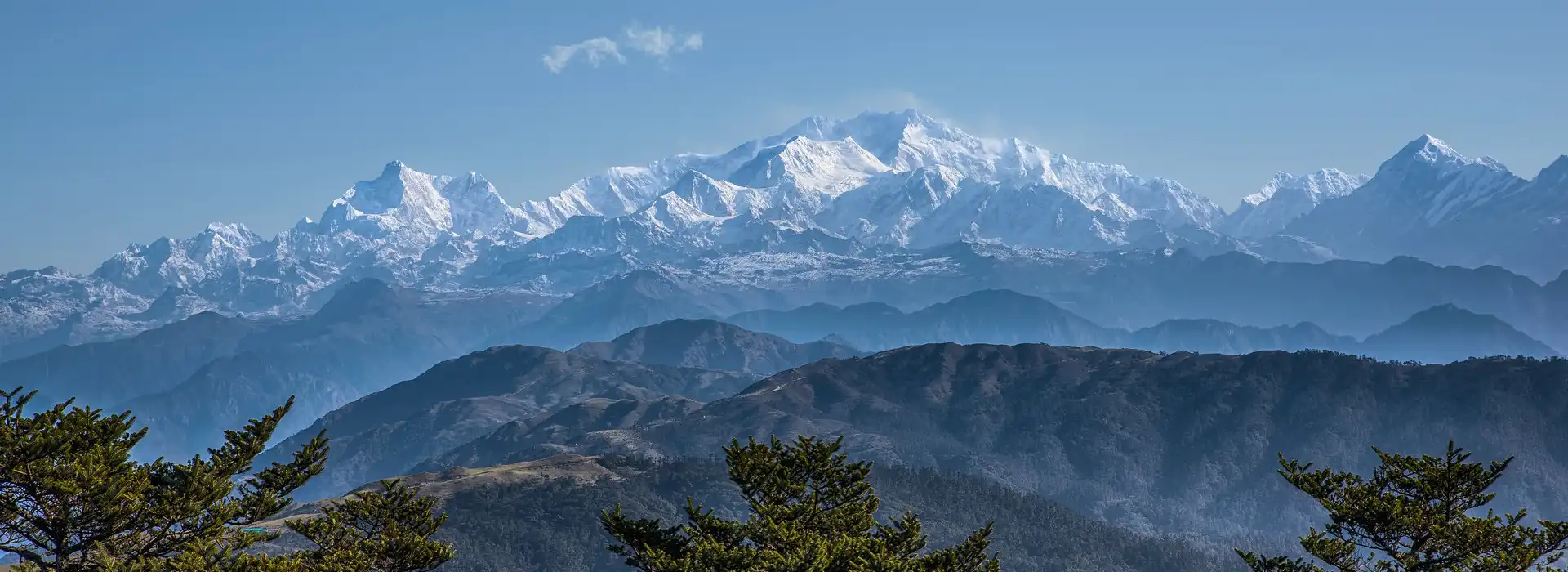
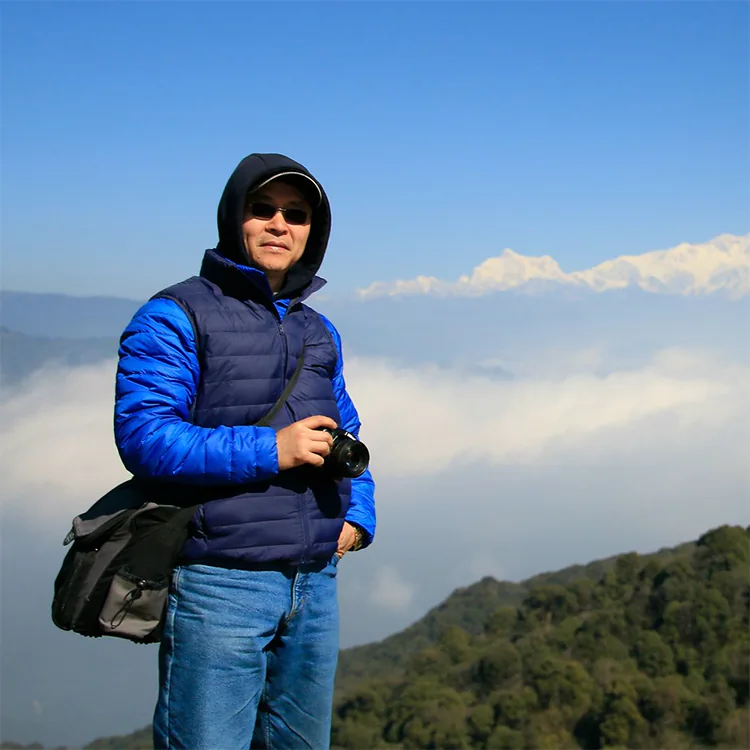
The Kanchenjunga Base Camp Trek takes you to the base of Mount Kanchenjunga, the third-highest mountain in the world. This trek challenges avid hikers and immerses them in the stunning landscapes and untouched wilderness of the Kanchenjunga region. As a less-traveled path compared to other high-altitude treks in Nepal, it allows trekkers to experience the remote beauty of Himalayan trekking in its purest form.
Mount Kanchenjunga, standing tall at 8,586 meters, creates a magnificent backdrop throughout the trip. The Kanchenjunga trek passes through a variety of ecosystems, from lush subtropical forests to arid alpine zones, making each part of the trek unique and unforgettable. With its rough terrain and amazing views of the surrounding peaks, the Kanchenjunga base camp is an even more exciting place to visit, adding to the sense of adventure.
The Kanchenjunga Base Camp Trekking circuit covers a substantial distance, often exceeding 200 kilometers round trip. The adventure typically begins with a scenic flight or drive from Kathmandu to Taplejung, the gateway to the Kanchenjunga Himal. From there, the trail winds through remote villages and high mountain passes, offering a glimpse into the local communities and the region’s rich biodiversity. Every step toward the base camp of Kanchenjunga builds anticipation, making the final arrival an incredibly rewarding achievement.
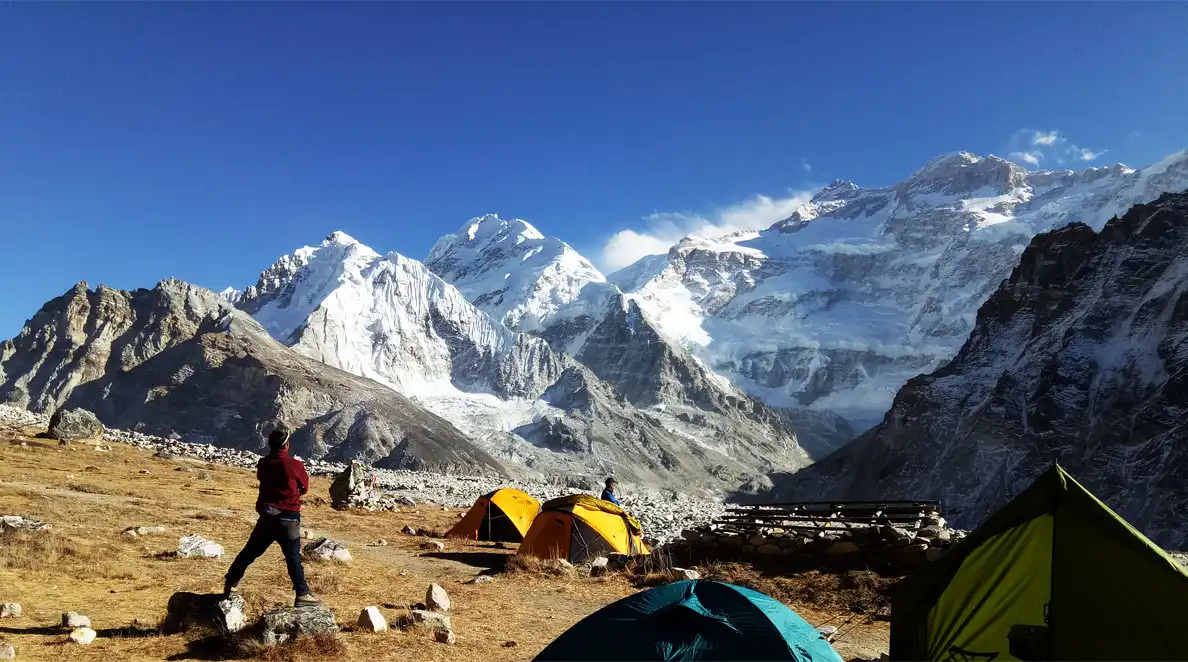
Kanchenjunga Base Camp
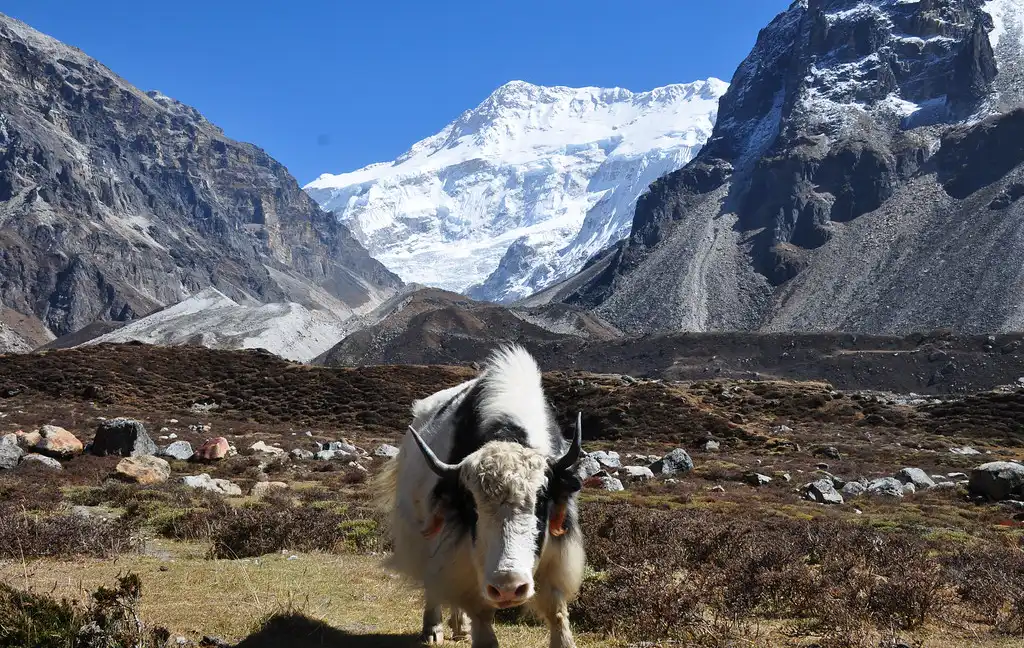
Yak grazing in front of Kanchenjunga mountains.
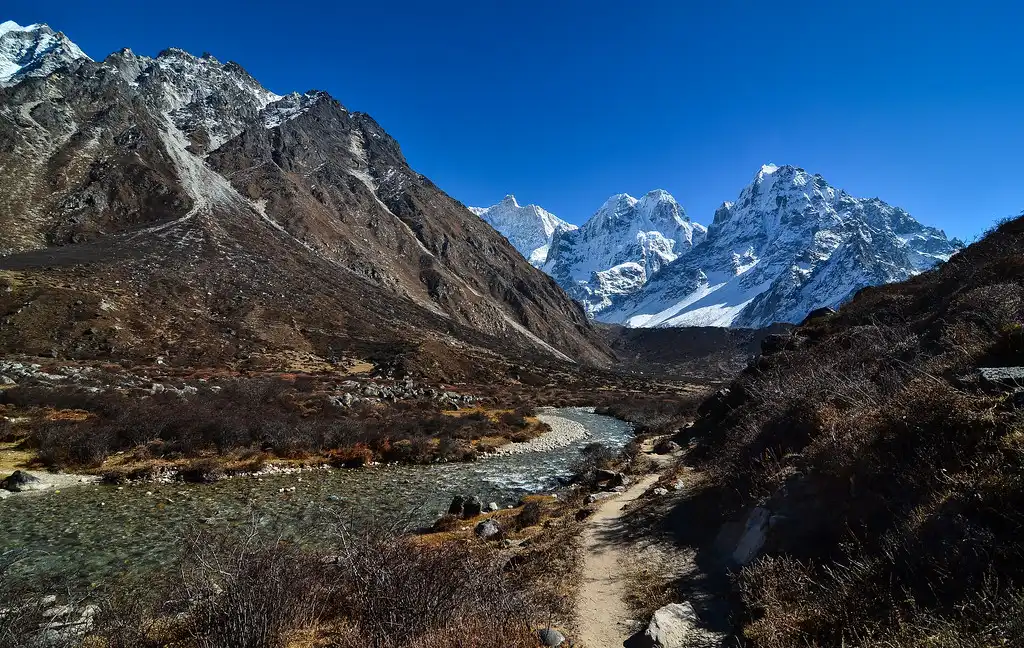
Kanchenjunga Base Camp Trekking Route
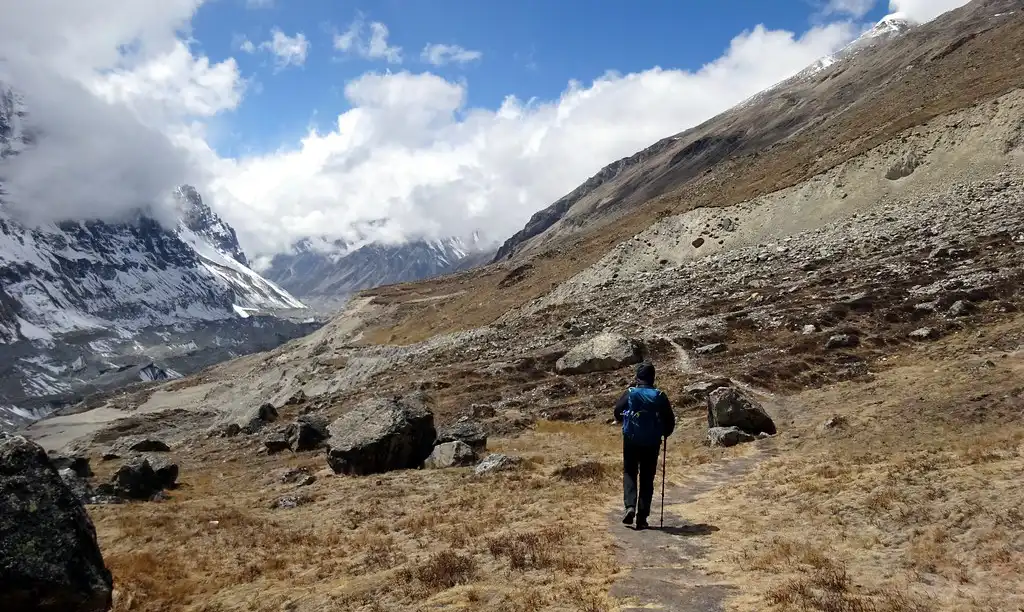
Leaving Pangpema
When you arrive at Kathmandu’s Tribhuvan International Airport, a representative from Peregrine Treks and Tours will meet you and transport you to the hotel. Use this day to unwind from your travel and start acclimating to the altitude. Before going on an exploration, spend some time relaxing at the hotel.
The Kanchenjunga Base Camp Trek begins in Kathmandu, the energetic capital of Nepal. You can explore local markets, take a stroll through the bustling streets, and sample some traditional Nepali cuisine, depending on when you arrive. This quick tour provides a mild introduction to the vibrant culture and establishes the scene for your trekking.
Spend the day exploring Kathmandu’s rich cultural heritage. Visit Swayambhunath, known as the Monkey Temple, for its stunning views and spiritual vibe. Head to Pashupatinath, a significant Hindu temple, where you can witness rituals along the sacred Bagmati River. Next, visit Boudhanath, one of the largest stupas in the world and a key center for Tibetan Buddhism.
In the afternoon, explore Durbar Square, the historical heart of Kathmandu, filled with ancient palaces, courtyards, and temples. This day also includes a pre-trek briefing, providing essential information about the upcoming trek, and a gear check to ensure you have everything you need. This preparation will set you up for a successful Kanchenjunga Base Camp Trek.
Take a morning flight from Kathmandu to Bhadrapur, enjoying aerial views of the Himalayas. Upon arrival in Bhadrapur, you will take a scenic drive to Ilam, a picturesque hill town known for its lush tea gardens. The trip offers breathtaking views of green hills, terraced fields, and quaint villages.
Arrive in Ilam and check into your lodge. In the evening, take a stroll through the town and enjoy its serene atmosphere. The overnight stay in Ilam provides a peaceful retreat and a chance to rest before continuing your trip toward the starting point of your trek.
Driving from Ilam to Taplejung, you start your adventure on the Kanchenjunga Base Camp Trek. The road winds through stunning landscapes featuring terraced fields, dense forests, and charming villages. You’ll enjoy views of rolling green hills and occasional glimpses of snow-capped peaks.
Arriving in Taplejung, the gateway to the Kanchenjunga region, your excitement will build for the trek ahead. Spend the evening in a local lodge, soaking in the tranquility and preparing for the trek.
Start the Kanchenjunga Base Camp Trek by trekking from Taplejung to Mitlung. The trail descends through lush green hills, passing traditional villages with terraced fields. Follow the soothing flow of the Tamor River along the way.
Enjoy the scenic beauty and serene environment as you trek to Mitlung. The well-marked and relatively gentle path makes for a pleasant start. Arrive in Mitlung, settle into your lodge for the night, and prepare for the next day’s trek.
Continue from Mitlung to Chiruwa, trekking through diverse landscapes filled with flora and fauna. Pass through several Limbu and Tamang villages, observing local life and interacting with friendly residents.
Cross suspension bridges and walk alongside terraced fields, experiencing varied terrains. The trail offers both gentle and moderate sections, keeping the trek engaging. Arrive in Chiruwa, check into your lodge, and reflect on the day’s cultural and natural highlights. The blend of beauty and experiences makes the Kanchenjunga Base Camp Trek truly memorable.
Trek through dense forests and along the Tamor River, enjoying the lush greenery. Pass through villages like Taplethok and Lelep, observing the local lifestyle and customs. The trail has a few strong ascents and descents that make the trek a little more difficult.
As you approach Sukethum, the scenery becomes even more captivating. Arrive at Sukethum and check into your lodge for the night. This section of the Trek to Kanchenjunga Base Camp offers an amazing blend of cultural encounters and scenic splendor.
Follow the Ghunsa Khola, trekking through steep and exposed terrain. Admire breathtaking views of the surroundings, and add excitement to the trek with multiple bridge crossings. The route is challenging but rewarding, with the serene beauty of nature keeping you motivated.
Reach the Tibetan village of Amjilosa by the end of the day. The village’s unique culture and architecture offer a glimpse into the Tibetan way of life.
Trek through lush rhododendron and bamboo forests, steadily ascending to Gyabla. The path includes a mix of steep ascents and descents, making it an engaging hike. Along the way, a magnificent waterfall passes, a highlight of this stretch.
Arrive in Gyabla and settle into your lodge. The day’s trek through diverse landscapes showcases the natural beauty that makes the Kanchenjunga Base Camp Trek so special. Enjoy a restful evening in this tranquil village.
Leave Gyabla and trek through a broad meadow, taking in expansive views. After descending from a short hill and crossing a river, you will eventually arrive at the Tibetan settlement of Ghunsa. Known for its wooden houses, micro-hydropower plant, school, and health post, Ghunsa offers a unique blend of culture and community.
Spend the night in a lodge in Ghunsa, experiencing the warmth of the local hospitality. The village’s charm and the friendly locals make this a memorable stop on your Kanchenjunga Base Camp Trek.
Spend the day acclimatizing with a short hike to a nearby viewpoint, gaining about 400m in elevation. This hike helps your body adjust to the altitude, reducing the risk of altitude sickness. After the hike, explore Ghunsa, visit its monasteries, and learn about the local Buddhist culture.
The acclimatization day is crucial for ensuring a safe and enjoyable trek to higher altitudes. Enjoy the peaceful atmosphere of Ghunsa, resting and preparing for the challenging days ahead. This day on the Kanchenjunga Base Camp Trek balances activity and relaxation, setting you up for success on your trek.
Follow the forested path along the Ghunsa Khola, enjoying the soothing sounds of the river. Pass by Mani walls and Chortens, which are significant to the local Buddhist culture. The trail features a mix of gentle paths and challenging sections over scree slopes and glacial moraines.
Upon reaching Khangpachen, you will enjoy stunning views of the north face of Jannu. This area offers a breathtaking backdrop for your overnight stay. The lodge provides a comfortable place to rest and prepare for the next day’s trek.
Trek along the left side of the Kanchenjunga Glacier, traversing a high plateau that offers panoramic views. This part of the trail allows you to see majestic peaks like Wedge Peak, Mera Peak, Nepal Peak, and Twins. The scenery here is truly awe-inspiring, with expansive vistas stretching in all directions.
Arrive in Lhonak, where you’ll find yourself in a remote and serene location. The lodge in Lhonak provides a place to relax and soak in the high-altitude environment. The day’s trek, filled with spectacular mountain views, underscores why the Kanchenjunga Base Camp Trek is a favorite among trekkers.
Start early to trek to Kanchenjunga Base Camp, also known as Pang Pema. The trail follows the glacier, gradually ascending to the base camp. Here, you’ll enjoy unparalleled views of Mount Kanchenjunga and the surrounding peaks, a highlight of the Kanchenjunga Base Camp Trek.
After spending time at the base camp, taking photos, and absorbing the stunning scenery, you’ll return to Lhonak. This trek back allows you to revisit the beautiful landscapes from a different perspective. Overnight at the lodge in Lhonak, where you can rest after an exhilarating day.
Retrace your steps from Lhonak to Ghunsa, passing through the familiar but still stunning landscapes. The descent provides a different viewpoint of the natural beauty you encounter on the ascent.
Arrive back in Ghunsa, feeling a sense of accomplishment for having reached the high point of your trek. Spend the night in the lodge, enjoying the warm hospitality and preparing for the next stage of your trip on the Kanchenjunga Base Camp Trek.
Leave Ghunsa and trek through a forested area filled with birch, pine, and rhododendron trees. The trail offers spectacular views as you gain elevation, particularly of Jannu and other surrounding peaks.
You will enjoy panoramic vistas at High Camp that will leave a lasting impression. The lodge at High Camp provides a comfortable resting place after a challenging day, ensuring you’re ready for the next day’s adventure.
Prepare for a challenging but rewarding day as you cross two high passes, Sele La (4480m) and Sinion La (4660m). The trek offers panoramic mountain views that make the effort worthwhile, showcasing the grandeur of the Himalayas.
Descend to Tseram, where you’ll find a welcoming lodge to rest. The day’s trek, filled with incredible scenery and the achievement of crossing two high passes, marks a significant milestone in the Kanchenjunga Base Camp Trek.
Continue trekking through stunning landscapes, moving from Tseram to Ramche. The trail offers varied terrain and captivating views, keeping the trek interesting and visually rewarding.
Arrive in Ramche and settle into your lodge for the night. This part of the trek highlights the diverse beauty of the Kanchenjunga region, ensuring that every step on the Kanchenjunga Base Camp Trek is memorable.
Spend the day exploring Yalung Base Camp, surrounded by magnificent mountain views—Marvel at the breathtaking vistas of the southern face of Kanchenjunga and the surrounding peaks. Enjoy the serene beauty, capturing the majestic scenery with your camera.
After a day of exploration and photography, return to Ramche for the night. The lodge in Ramche offers a cozy place to rest, providing comfort after a day filled with the natural splendor that makes the Kanchenjunga Base Camp Trek so memorable.
Head back towards Tortong, descending through beautiful forests and meadows. The trail combines gentle paths with steeper sections, making the hike both engaging and interesting.
Upon arriving in Tortong, check into your lodge for the night. The descent brings you back through the diverse landscapes encountered earlier, allowing a fresh perspective on the Kanchenjunga Base Camp Trek.
Continue descending through lush landscapes on your way to Yamphudin. The trail meanders through dense forests and alongside rivers, offering plenty of scenic spots to enjoy.
Upon reaching Yamphudin, settle into a welcoming lodge for the night. This segment of the trek allows you to experience the rich biodiversity and natural beauty that characterize the Kanchenjunga Base Camp Trek.
Trek through terraced fields and small villages, heading towards Mamangkhe. The path takes you through rural areas where you can observe the traditional way of life of the local communities.
Arrive in Mamangkhe and settle into your lodge for the night. The day’s trek, filled with cultural encounters and beautiful landscapes, highlights the diverse experiences offered by the Kanchenjunga Base Camp Trek.
Climb through diverse landscapes, passing several small settlements before reaching Khesewa. The trek is interesting since the trail features a range of terrains, from wide fields to lush woodlands.
Spend the night in a lodge in Khesewa, reflecting on the day’s trip. This segment of the Kanchenjunga Base Camp Trek showcases the region’s natural and cultural diversity.
Finish the trek by hiking back to Taplejung. The path takes you through familiar landscapes, offering a final opportunity to enjoy the stunning scenery of the Kanchenjunga region.
Upon reaching Taplejung, drive back to Bhadrapur for an overnight stay at a lodge. This day marks the end of your trekking adventure, with the drive providing a chance to relax and reflect on the Kanchenjunga Base Camp Trek.
Take a morning flight back to Kathmandu. Use this time to explore more of the city or rest and recover from your trek.
Spend the night at a hotel in Kathmandu, enjoying the comforts of the city after your adventure in the mountains. The return to Kathmandu offers a final contrast between the bustling city and the serene trails of the Kanchenjunga Base Camp Trek.
I depart from Kathmandu and take unforgettable memories of the Kanchenjunga Base Camp Trek with you. Reflect on the incredible trip and the stunning landscapes experienced. Your departure marks the end of an epic adventure through one of the most beautiful regions in the Himalayas.
Trekkers on the Kanchenjunga Base Camp Trek stay primarily in teahouses and lodges, which offer basic yet comfortable lodging options. Local families run these accommodations, providing a unique glimpse into the local culture and warm hospitality.
Typically, teahouses offer small rooms equipped with a bed, blanket, and pillow. In more remote areas, facilities might be more rudimentary, with shared bathrooms and limited amenities. Despite the simplicity, the hosts’ warmth and friendliness create a cozy and welcoming environment after a long day of trekking.
Meals on the Kanchenjunga Base Camp Trek are simple yet nourishing, designed to sustain trekkers through the demanding trip. Teahouses and lodges serve a variety of local dishes, such as dal bhat (lentil soup with rice), momo (dumplings), and thukpa (noodle soup).
These meals are rich in carbohydrates, providing the energy needed for trekking. Additionally, trekkers can find Western options like pasta, pancakes, and omelets. Staying hydrated is crucial, so drinking plenty of water, tea, or soups is recommended. Trekkers should also bring high-energy snacks like nuts, dried fruits, and energy bars to supplement their diet.
Spring is one of the best times to experience the Kanchenjunga Base Camp Trek. The weather is usually stable and mild, making it ideal for trekking. The trails come alive with blooming rhododendrons and other wildflowers, adding vibrant colors to the scenery.
In March, as the snow melts, temperatures rise, creating a pleasant atmosphere for trekkers. The lower regions turn lush and green, while the higher elevations retain a beautiful layer of snow, offering a stunning contrast. By April, the weather warms up further, and the skies remain mostly clear, providing excellent visibility of the surrounding peaks.
May brings even warmer temperatures, with landscapes bursting with greenery and flowers. The long, sunny days and breathtaking views of the snow-capped mountains make the Kanchenjunga Base Camp Trek an unforgettable experience during this month.
The best season for a trek to Kanchenjunga Base Camp is in autumn. Trekking and taking pictures of the breathtaking mountain vistas are ideal during the post-monsoon season, which has clear skies and steady weather.
In September, the landscape becomes lush and green as the monsoon ends. Clear skies and cool temperatures create a pleasant trekking environment with fewer crowds on the trails. October offers the best conditions for trekking, with moderate temperatures, crisp air, and spectacular views of Kanchenjunga and the surrounding peaks.
By November, temperatures drop, especially at higher altitudes, but the skies stay clear. The trails become less crowded than in October, providing a peaceful trekking experience. With the right gear, the colder weather is manageable, and the snow-covered peaks make the trek unforgettable.
In winter, it is not advisable to trek to Kanchenjunga Base Camp because of the severe weather. The walk might be hazardous and difficult due to the low temperatures and abundant snowfall.
From December to February, temperatures plunge, particularly at higher elevations. Heavy snowfall can block trails and make some passes impassable. The shorter days and intense cold increase the difficulty, making trekking conditions far from ideal.
Only very experienced trekkers with appropriate gear should consider trekking during this time. The extreme weather can be hard to endure, limiting the number of safe and enjoyable trekking days.
The summer months, which coincide with the monsoon season, are not suitable for the Kanchenjunga Base Camp Trek. The heavy rainfall during this period creates hazardous trekking conditions.
From June to August, the monsoon season brings heavy rains that make the trails slippery and muddy. Landslides and leeches can become significant issues, and frequent rain and cloud cover often obscure mountain views.
The high risk of weather-related disruptions makes this season less favorable for trekking. However, the lower regions are lush and green, offering a unique natural beauty for those who are willing to brave the weather.
The Kanchenjunga Base Camp Trek ranks among Nepal’s most challenging treks, demanding high levels of fitness, endurance, and preparation. Trekkers navigate through remote areas, ascend to high altitudes, and traverse rugged terrains. This trek suits experienced adventurers looking for a less-traveled and exhilarating route. Key Factors Contributing to the Difficulty are listed below:
The Kanchenjunga Base Camp Trek ascends to elevations above 5,000 meters, peaking at Kanchenjunga Base Camp around 5,143 meters. High-altitude trekking can lead to Acute Mountain Sickness (AMS), which requires careful acclimatization. Trekkers should monitor their health for symptoms like headaches, dizziness, and nausea and take immediate action, such as descending if symptoms persist.
This trek features a gradual ascent to help with acclimatization, but the risk of altitude sickness remains. Trekkers should plan for acclimatization days and avoid rapid ascents. Staying hydrated, eating nutritious meals, and maintaining a steady pace are crucial for reducing the risks associated with high altitudes on the Kanchenjunga Base Camp Trek.
The trail includes rocky paths, scree slopes, and glacial moraines, making navigation challenging, especially in wet or snowy conditions. Trekkers need good balance, sturdy footwear, and trekking poles for stability. The unpredictable trail conditions require constant vigilance and careful footing.
The Kanchenjunga Base Camp Trek involves significant elevation changes with steep ascents and descents, demanding strong leg muscles and good cardiovascular fitness. The remoteness of the region means fewer amenities and limited access to rescue services, so trekkers must be self-sufficient and carry essential supplies like food, water, and a first-aid kit.
The weather in the Himalayas changes quickly, bringing challenges like heavy rain, snow, and cold temperatures, especially at higher altitudes. Trekkers must prepare for these conditions as they can significantly impact the trek.
The pre-monsoon (spring) and post-monsoon (autumn) seasons are ideal for completing the Kanchenjunga Base Camp Trek because of the comparatively consistent weather during these periods. Trekkers should nevertheless pack for inclement weather even at these ideal times.
Trekkers must be in excellent physical condition, with strong cardiovascular and muscular fitness. Previous high-altitude trekking experience is highly beneficial for coping with the strenuous demands of the Kanchenjunga Base Camp Trek.
The remote and challenging nature of the trek requires significant mental resilience. Trekkers should prepare for long days of hiking and the psychological demands of being in a remote environment, which includes limited access to amenities and emergency services.
For the Kanchenjunga Base camp Trek, there are many benefits to hiring a porter and guide. Guides offer vital insider information on the area’s geography, history, and culture. They enhance safety by navigating tricky trails and offering help in emergencies. Porters carry your heavy gear, allowing you to trek with a lighter load, reducing fatigue, and increasing your overall enjoyment. This support lets you focus on the trekking experience itself rather than the logistics and physical challenges.
To find reliable guides and porters for the Kanchenjunga Base Camp Trek, start by contacting reputable trekking agencies in Kathmandu or Taplejung. These agencies typically have experienced and licensed guides and porters on staff. Additionally, read online reviews and seek recommendations from fellow trekkers who have completed the trek. Always verify the credentials and experience of potential guides and porters to ensure they meet your specific needs and expectations.
For the Kanchenjunga Base Camp Trek, comprehensive travel insurance is crucial due to the trek’s remote and challenging nature. Your policy should cover emergency medical expenses, including hospital visits and treatments. Make sure your insurance covers altitude-related illnesses and high-altitude trekking since you will be trekking at a high altitude.
Ensure that your insurance covers emergency evacuation. In the remote regions of the Kanchenjunga trek, helicopter evacuations might be necessary in case of severe health issues or accidents. Your policy should also cover search and rescue operations, as these services are expensive but essential for safety in emergencies. Verify the details of your policy to ensure it meets the specific requirements of high-altitude trekking before starting your adventure.
Kanchenjunga Restricted Permits: Cost $20 per person per week.
Kanchenjunga Conservation Fees: Cost $30 per person.
TIMS (Trekkers Information Management System) Card: Cost $20 per person.
Documents Needed: You must have an original passport with a valid visa to obtain the restricted permits.
You can reach Kathmandu by flying into Tribhuvan International Airport, which connects to many major international cities. To get to the Kanchenjunga trekking region, take a domestic flight from Kathmandu to either Bhadrapur or Suketar.
From Bhadrapur, a drive to Taplejung serves as the trek’s starting point. Within the region, private jeeps and local buses are available, offering flexible transportation options based on your budget and schedule.
Yes, the Kanchenjunga Base Camp Trek is challenging. It involves high altitudes, long distances, and rugged terrain. Aside from having prior trekking experience, trekkers must be in top physical shape. It is a challenging trek that is best suited for experienced hikers due to its remote and less-traveled landscape.
Typically, the trek to Kanchenjunga Base Camp takes between 20 and 24 days. This time frame varies based on the exact itinerary and requirements for acclimatization. The trek covers roughly 200 kilometers in a round trip, with multiple days of continuous trekking.
The cost of trekking to Kanchenjunga Base Camp varies, but it generally ranges from $2,600 to $3,000 per person. This cost includes permits, guide and porter fees, accommodation, meals, and transportation. For more detailed pricing, you can refer to Nepal Everest Trekking.
Pelling, located in Sikkim, India, is not directly connected to Kanchenjunga Base Camp in Nepal. The trek to Kanchenjunga base camp starts from Taplejung in Nepal, and there is no direct trekking route from Pelling to the base camp.
Kanchenjunga Base Camp Trek feels more challenging than Everest Base Camp Trek due to its remoteness and fewer amenities. However, climbing Mount Everest is significantly more difficult and dangerous than climbing Mount Kanchenjunga due to higher altitudes and more extreme conditions.
The best base camp trek varies based on personal preferences. Popular choices include Everest Base Camp Trek for its iconic views, Annapurna Base Camp Trek for its diverse landscapes, and Kanchenjunga Base Camp Trek for its remoteness and pristine beauty.
The Goecha La treks is the best base camp hike in Sikkim. It passes through breathtaking scenery, offering breathtaking views of Mount Kanchenjunga and other high peaks, as well as a rich cultural experience.
Climbing Mount Kanchenjunga requires advanced mountaineering skills, extensive experience, and physical fitness. Only experienced climbers with high-altitude expedition experience should attempt to climb Kanchenjunga.
Climbing Mount Kanchenjunga requires advanced mountaineering skills, extensive experience, and physical fitness. Only experienced climbers with high-altitude expedition experience should attempt to climb Kanchenjunga.
Kanchenjunga Base Camp sits at an altitude of approximately 5,143 meters (16,873 feet).
The Kanchenjunga Base Camp Trek is hard due to its length, high altitude, and remote terrain. Trekkers must be well-prepared, physically fit, and mentally resilient to handle the challenges.
Darjeeling does not directly connect to Kanchenjunga Base Camp in Nepal. Trekkers access the base camp from Taplejung in Nepal, as there is no direct route from Darjeeling.
The Kanchenjunga Base Camp Trek is difficult due to its remote location, high altitude, and challenging terrain. Climbers attempting to summit Kanchenjunga face even greater difficulty due to extreme weather conditions, technical climbing requirements, and high risk.
Trekking to Kanchenjunga Base Camp is generally safe if you take proper precautions. These include acclimatization, traveling with experienced guides, and carrying necessary gear. However, the remote nature of the trek can pose challenges in case of emergencies.
Kanchenjunga holds a mysterious allure due to its remote location, challenging climbs, and less explored trails. Locals revere it in mythology and consider it sacred. Legends and stories about the mountain add to its mystique, making it an intriguing destination for trekkers and climbers alike.

Based on 3 Reviews

I had an incredible experience trekking to Kanchenjunga Base Camp with Peregrine Treks and Tours. The remote trails and stunning mountain views were absolutely breathtaking. The guides were knowledgeable and ensured our safety at all times. I highly recommend this trek for any experienced trekker looking for an adventure off the beaten path.

Excellent






The Kanchenjunga Base Camp Trek with Peregrine Treks and Tours was a once-in-a-lifetime experience. The diverse landscapes, from lush forests to high-altitude meadows, were mesmerizing. The cultural interactions with local communities added a unique touch to the trek. Peregrine Treks and Tours provided excellent support throughout the trip,

Excellent






Trekking to Kanchenjunga Base Camp was challenging but incredibly rewarding. Peregrine Treks and Tours made sure everything was well-organized, from permits to accommodations. The guides were fantastic, sharing their extensive knowledge of the region and its wildlife. This trek is a must-do for serious trekkers.

Excellent





